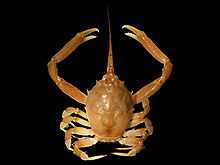Corystes
| Corystes cassivelaunus | |
|---|---|
 | |
| A male C. cassivelaunus | |
| Scientific classification | |
| Kingdom: | Animalia |
| Phylum: | Arthropoda |
| Subphylum: | Crustacea |
| Class: | Malacostraca |
| Order: | Decapoda |
| Infraorder: | Brachyura |
| Family: | Corystidae |
| Genus: | Corystes Bosc, 1802 |
| Species: | C. cassivelaunus |
| Binomial name | |
| Corystes cassivelaunus (Pennant, 1777) | |
| Synonyms | |
Corystes cassivelaunus, the masked crab, helmet crab or sand crab,[1] is a burrowing crab of the North Atlantic and North Sea from Portugal to Norway, which also occurs in the Mediterranean Sea.[2] It may grow up to 4 centimetres or 1.6 inches long (carapace length).[1] The name "masked crab" derives from the patterns on the carapace which resemble a human face, in a similar manner to heikegani.[3] It is the only species in the genus Corystes.[4]
C. cassivelaunus lives buried in sandy substrates, where it feeds on the infaunal invertebrates such as polychaete worms and bivalve molluscs.[1] It uses its two antennae to form a breathing tube that allows oxygenated water down into the substrate.[5][6] The chelipeds of males are much longer than the body, while those of females are only about as long as the carapace.[7]
References
- ↑ 1.0 1.1 1.2 "Masked crab (Corystes cassivelaunus)". ARKive.org. Retrieved November 14, 2006.
- ↑ "Crabs of the Southern North Sea". Department Zeevisserij (Sea Fisheries Department). October 8, 2001.
- ↑ Webster's Revised Unabridged Dictionary (1913). masked crab.
- ↑ Peter Davie & Michael Türkay (2011). "Corystes Bosc, 1802". World Register of Marine Species. Retrieved June 7, 2012.
- ↑ "Helmkrab" (in Dutch). Waddenzee.nl. Retrieved January 9, 2010.
- ↑ "Masked crab, Corystes cassivelaunus". Sefton Coast.
- ↑ M. J. De Kluijver. & S. S. Ingalsuo. "Corystes cassivelaunus". Macrobenthos of the North Sea: Crustacea. Universiteit van Amsterdam. Retrieved January 9, 2010.